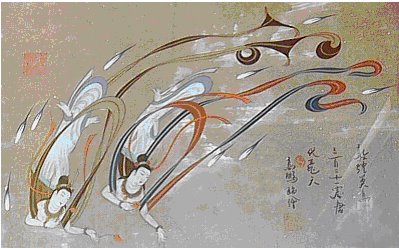. - - - - - ABC-List of the Sennin Immortals Hermits - - - - - .
. sennin 仙人と伝説 Legends about Immortals .
::::::::::::::::::::::::::::::::::::::::::::::::::::::::::::::::::::::::::::::::::::::::::::::::::::::::::::::::::::::::::::::::::::::::::::::::::::::::::::::::::::::::::::::
Yooro Sennin 養老仙人 Yoro Sennin
and
Nanigashi 草野某(なにがし)
He is Nr. 07 of the
. 日本の仏仙人16人 - The 16 Buddhist Immortals of Japan .
Not much is known about this Sennin. He was a poor 樵夫 forest worker in 美濃国多藝郡 Mino no kuni, Tagenokoori(たげのこおり)
now 多芸郡(たぎぐん)岐阜県(美濃国) Tagi district, Gifu.
As a reward for his filial piety he obtained longevity.
The water of the waterfall does not only turn to Sake, it also heals various ailments of humans.
Some people come here to get the water and have even seen an old man near the fall.
Sake no Izumi 酒の泉 the fountain of Sake

- quote -
Yoro’s power is outlined in an old legend about a poor woodcutter who went into the woods to find firewood, and discovered the water of the spring had turned to rice wine. He filled a hyooten ひょうたん gourd with the spring water and brought it to his aged and ill father, who was returned to good health by the wine. The water-to-sake transformation was believed to be the gods rewarding the son for his dedication to his father.
.....
The Empress Genshō, visited the area, and renamed the period of her reign after it ...
- source : japaninfoswap.com/yoro-no-taki... -
元正天皇の霊亀三年、この樵夫の孝咸(こうかん)に因りて同郡多度山より醴泉(れいせん)出せり。故に改元ありて、霊亀の年号を改めて養老とせらる。これを以てこの樵夫の孝名、普(あまね)く世に知られたり。然れども、この樵夫が道を得て神仙となりたることは、未だこれを知る者無かりき。
- more
- reference source : nihonkogaku.com/content/report... -
Yōrō (養老) was a Japanese era name (年号 nengō, "year name") after Reiki and before Jinki.
This period spanned the years from November 717 through February 724. The reigning empress was Genshō-tennō (元正天皇).
The gourd, a most common water container for travelers in the Edo period, has become the symbol of Yoro town and there is a Gourd Festival.

ひょうたんと養老
..............................................................................................................................................
Yooro no Taki 養老の滝 Yoro no Taki Waterfall
The famous Yōrō Falls (養老の滝, Yōrō no Taki) is a waterfall in Yōrō Park located in the town of Yōrō.
There are a few other waterfalls in Japan with this name.
yooro no kooko 養老の孝子 filial piety at Yoro

about 26 cm high
. Yooro no Taki 養老の滝 Yoro no Taki Waterfall .
Once a pious son scooped some water from the waterfall pool and brought it home to his old parents.
When they took a sip - oh wonder - it had turned into sake and all their ailments were healed.
...........................................................................
Kooshi jinja 孝子神社 (こうしじんじゃ)"Shrine of the Filial Piety"

岐阜県養老郡養老町 / Yoro Town Gifu
- reference source : sake.science/yoro... -
..............................................................................................................................................
松尾芭蕉 Matsuo Basho wrote:
盃の下ゆく菊や朽木盆
sakazuki no shita yuku kiku ya Kitsuki bon
below the sake cup
there is a chrysanthemum -
tray from Kitsuki
Written in 1675, 延宝3年, Basho age 32.
He took the inspriation from an old song, Yooroo 養老 Yoro.
The sake in the small cup is overflowing rapidly and becomes the famous waterfall of Yoro. Its flow looks like the chrysanthemums flowing in the river.

. Kitsuki bon 朽木盆 tray from Kitsuki .
::::::::::::::::::::::::::::::::::::::::::::::::::::::::::::::::::::::::::::::::::::::::::::::::::::::::::::::::::::::::::::::::::::::::::::::::::::::::::::::::::::::::::::::
Nanigashi 草野某(なにがし)
was a Samurai who lived around 1580 in 美濃国本巣郡 Mino no Kuni, Motosu gun district.
His family was very poor and he lost his father at age 4. He was brought up by relatives and later went to Kyoto to the temple 西園寺 Saion-Ji.
There he got a letter from his mother, who was very ill and wanted him to come back soon. On his way he got involved in fights between Toyotomi Hideyoshi and Shibata Katsuie, but managed to find his way home. His mother was very pleased to see him. He took some medicine from his luggage and gave it to his mother as an expression of his filial piety.
Since his family was so poor, they could only eat rice and wild vegetables, and he decided to practise ablutions and austerities at the waterfall.
His mother died shortly after, but he had obtained the power to fly and change places freely and eventually left the waterfall to become an Immortal.
.......................................................................
HŌJŌGAWA - a noh play by kanze motokiyo zeami
Hachiman River
I am Chikuba Nanigashi, priest at the Kashima Shrine.
- Read the full translation
- source : ross bender -
::::::::::::::::::::::::::::::::::::::::::::::::::::::::::::::::::::::::::::::::::::::::::::::::::::::::::::::::::::::::::::::::::::::::::::::::::::::::::::::::::::::::::::::
. Japanese Legends - 伝説 民話 昔話 – ABC-List .
The story of the filial piety and healing water from the waterfall is also known in 千葉県 Chiba, 香川県 Kagawa, 兵庫県 Hyogo and 茨城県 Ibaraki.
................................................................................. Gifu 岐阜県 養老町 Yoro
The son had to care for his father, who loved to drink Sake . . . and then found the miraculous pond at the foot of the waterfall.
kogane take 黄金竹 golden bamboo
美濃の養老の滝にある神社の後方に、毎年二本ずつ生えるが、一年で枯れる竹があるといわれていた。
tengu 天狗
美濃国養老郡一の瀬村付近では、大きな天狗の面を作り、村人が鉦や太鼓で囃したてながら隣村へと順に送り、山奥深くまで送っていく天狗祭がある。天狗が村里に出現して人畜に該をなすのを封ずるためであるという。明治初年まで行われていたらしい。
ubakiri ishi 姥切石
昔、石の傍らで悶死した女の霊が石に乗り移った。夜中になると石は人肌ほどに暖かくなり、奇声を発した。京都の高僧が歌を詠み、喝を入れるとそうならなくなった。その石は姥切石と呼ばれた。
zengashi iwa 膳貸岩
養老塚という石がある。法要のあるときに必要な数の膳椀を頼めば、翌日には岩の上に希望の数だけ膳椀があった。ある時1つを破損して岩上に返したためにそれ以来借りられなくなった。
..............................................................................................................................................
- reference : Nichibun Yokai Database -
::::::::::::::::::::::::::::::::::::::::::::::::::::::::::::::::::::::::::::::::::::::::::::::::::::::::::::::::::::::::::::::::::::::::::::::::::::::::::::::::::::::::::::::
. sennin 天狗と仙人伝説 Legends about Tengu and Immortals .
. sennin 仙人と伝説 Legends about Immortals .
. Japan - Shrines and Temples - Index .
[ . BACK to DARUMA MUSEUM . TOP . ]
[ . BACK to WORLDKIGO . TOP . ]
- - #senninyoro #yorosennin #nanigashi -
::::::::::::::::::::::::::::::::::::::::::::::::::::::::::::::::::::::::::::::::::::::::::::::::::::::::::::::::::::::::::::::::::::::::::::::::::::::::::::::::::::::::::::::













































